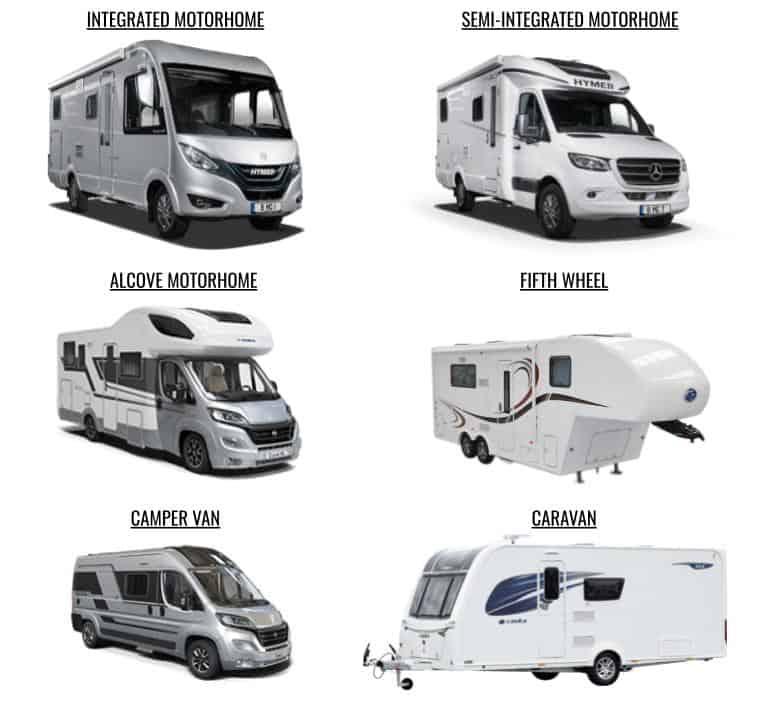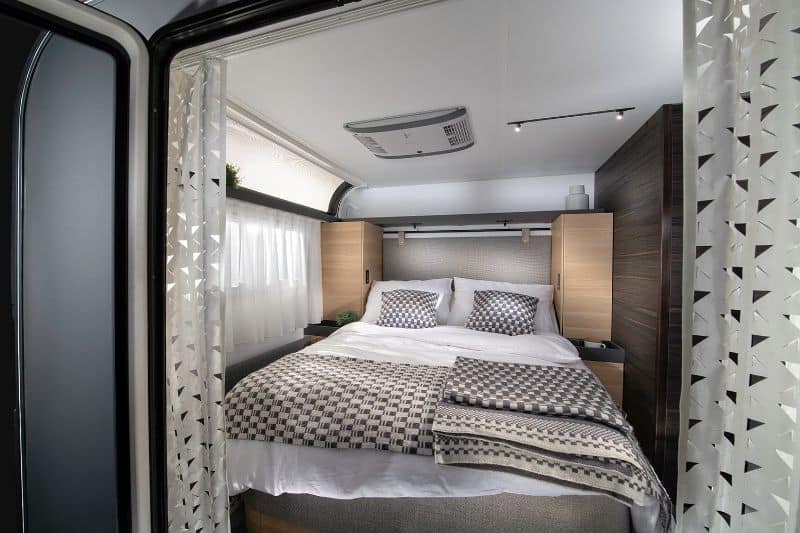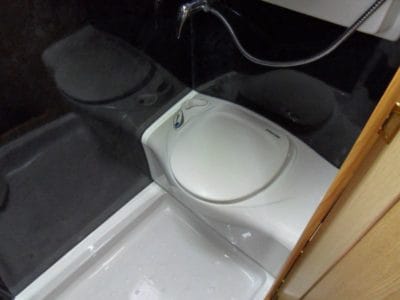RVs may be as American as apple pie, but other countries love recreational vehicles, too. You can find caravans in Australia and New Zealand, camper vans across Northern and Mediterranean Europe, and fang che in China. And, of course, you can find many RVs within our North American neighbors, Canada and Mexico.
Outside of the U.S., the most popular RVing destination in the world is Europe. If you’re planning an eye-opening cultural pilgrimage across Europe, what should you expect? And what are the differences between American RVs and European motorhomes?
If you’re just curious about the differences in the lifestyle, check out this firsthand account of a yearlong motorhome journey across Europe. But if you’re also curious about the rigs themselves, then read on!
European RV Classes Are Different
There are no “RVs” in Europe. That’s not a term they use. Instead, they make caravans and motorhomes. And don’t talk about “Class C’s” and “travel trailers.” People will just look at you like you’re weird.
Instead, Europeans refer to motorhomes as alcove motorhomes, semi-integrated motorhomes, or integrated motorhomes. That’s roughly similar to our Class C, Class B, and Class A motorhomes – but much more compact!

Travel trailers are called caravans. 5th wheels are very rare but don’t have a special moniker.
If you’re in a non-English-speaking country, they have their own names, but I can’t pronounce them. Germany calls a Class B a Kastenwagen, for instance, and a Class C is a Teilintegriert.
You should know most European motorhomes are built on the Mercedes Benz Sprinter, AL-KO Aluminum, or Fiat Ducato chassis. You don’t see the huge Freightliner, Ford or Spartan truck chassis.
| European | North American | Notes on European Use |
|---|---|---|
| Camper Van | Class B / Conversion Van | Very common! All built on van chassis. |
| Alcove Motorhome | Class C | Has bed alcove over the cabin. |
| Semi-Integrated Motorhome | Class B / Class B+ | Cabin chairs can swivel to face the living area. |
| Integrated Motorhome | Class A / Super C | Cabin is completely merged with the living area. |
| 5th Wheel (5er) | 5th Wheel | Very rare! Limited by weight and towing restrictions. |
| Caravan | Travel Trailer | Quite common. Most are narrower and shorter than US equivalents. |
| Truck Camper | Truck Camper | Less common. Full-size pickup trucks are relatively rare in Europe. |
They’re Drop-Dead Gorgeous
We Americans design RVs like we cook our hamburgers. And the recipe hasn’t changed much in 50 years. We’re still stuck in the browns, grays, ochres, and other earth tones of the 1970s. Even our attempts at modern design look more like a Hilton lobby than a super-modern RV.
The European RV manufacturers have left us in the dust, plain and simple. Just take a look at these pictures. You’ll see. Soft-close drawer slides, dimmable ambient lighting, curved edge-banded furniture, automotive-grade upholstery … pure poetry. As you can tell, I’m quite jealous!
What you DON’T find are 10-cent drawer latches that won’t latch, vinyl-coated OSB “hardwood,” giant gaps filled with caulk … yuck …
As an engineer, I appreciate their motivation to squeeze out every cubic foot – er, every cubic meter – they can find. You’ll find hidden storage cubbies under steps, beneath dinettes, in recessed overheads, and lots of storage in the “garage” area!


Can You Drive a Stick?
It’s all diesel and manual gearboxes over there! While you’ll find some high-end motorhomes with automatic transmissions, Europeans still rely on stick shifts for just about everything: cars, trucks, and RVs.
Also, most engines run on diesel, not gas. You’ll learn to love ‘em. You get massive low-end torque and excellent fuel economy. Unfortunately, fuel costs twice as much …
Smaller – Shorter Length
Everything is more compact in Europe. France is smaller than Texas. Restaurant portions are smaller. And the RVs are literally half the size of their American counterparts!

This is for many reasons:
- European roads are MUCH smaller and twistier
- “Wild camping” is available throughout much of Europe, especially the UK
- Road regulations are MUCH stricter, such as maximum weight and length
- Fuel costs MUCH more, so extra weight is very expensive!
The average European RV, whether motorhome or caravan, is about 18-23 feet in length. A 24-ft (8-meter) motorhome is a very popular size for a medium/large Class C/Class A RV.
Anything over 24 feet is considered very large and won’t be able to navigate all roads or campgrounds. You virtually never see motorhomes longer than 30 feet.
Smaller – Narrower Waist
You won’t find gas-guzzling Class A’s or Super C’s motoring about on European roads. Motorhomes and caravans are much narrower than American RVs, usually between 82-90 inches. That’s not much wider than a standard SUV or truck passenger vehicle!
Many European countries limit the maximum vehicle width on any road to about 2.5 meters, which is just over 8 feet. So wide-body RVs, at 102 inches, would be illegal on most of the continent!
Less Cargo Capacity
In Europe, you can’t just buy a vehicle half the size of a semi truck and timidly pilot it onto the open road. A normal Category B license is good for up to 3.5 metric tons (tonnes) GVWR. That’s about 7,700 lbs for you metrically-challenged folks.
So almost all European motorhomes are limited to about 7,700 lbs total weight. And if you tow a camper trailer, your total weight can’t exceed 7,700 lbs total weight.
That includes the weight of the unit and anything you add to it, like water or cargo! You need to carefully calculate the available cargo capacity left over!
And don’t forget – the weight restrictions mean you generally can’t tow a “toad” or “dinghy” vehicle behind a motorhome unless you have a special license!
No Slides or Expansions
It’s estimated only 2-3 percent of European motorhomes have slides. They’re just not a thing over the pond. As we Americans know, slides allow heat to leak out and water to leak in, neither of which Europeans will put up with. Plus, with such tight weight restrictions, European OEs aren’t in a hurry to add a few hundred pounds of hardware.
Slides are slowly making inroads into the market. You can find them in some manufacturers, like Adria. But as of now, they are not a desired feature.

Better 4-Season Insulation
As I’ve written about before, North American RV manufacturers really stretch the truth when it comes to their insulation R-value claims.

In Europe, they actually have a standard for measuring insulation! It’s EN-1646-1. RVs are rated as Grade 1, Grade 2, or Grade 3, with Grade 3 being the highest performance.
Somewhat confusingly, the standard has different criteria for caravans versus motorhomes. Caravans are rated by their cold-weather insulation, and motorhomes are rated by their heating performance.
Here are the grade heating requirements for motorhomes in the UK. Rules for caravans are actually somewhat stricter!
- Grade 1 means the heating has not been rated. The RV is designed for seasonal use.
- Grade 2 heating will achieve 20 °C (68 F) inside when it is 0 °C (32 F) outside.
- Grade 3 heating will achieve 20°C (68 F) inside when it is -5°C (23 F) outside and also requires that the fresh (but not waste) water supply must operate when it is -15°C (5 F) outside.
European travelers really care about their insulation (as they should, since they don’t have air conditioners). The thickness and type of insulation is often leveraged as a selling point.
Less Rugged Chassis Design
In America, we joke about our long dries, bad roads, and even worse weather (you either joke about it, or you cry about it).
But because of our rugged road conditions, we design chassis built for the long haul. Even though our leaf spring or torsion axle suspensions are rather utilitarian, they last a long time.
And most RV manufacturers pay attention to things like ground clearance and approach/departure angles. In places where an European RV would bog down or scrap the ground, a North American RV would cruise through. European RVs tend to be a lot lower to the ground.
On-Demand Water Heaters Are In Demand!
Here in the U.S., a 6-gallon water heater and a propane-powered furnace come standard on most RVs. Larger motorhomes might have a 10-gallon water heater.
In Europe, tankless (or instant) water heaters are more common. And in fact, you might even see a hydronic heating system like the Alde (popularized in the U.S. via NuCamp travel trailers). You also might found a combo furnace/water heater option like the Truma Combi, popularized in the U.S. in Winnebago Class B vans.
Get Used to Cassette Toilets
Most European caravans and RVs don’t have a conventional onboard black tank. They use a cassette toilet (which I talk about quite a bit here!).
Essentially, a cassette toilet is a permanent toilet with a removable black tank. You open an access door in the side of the unit, slide out the black tank, and roll the tank to the dump station.

As you can imagine, these tanks are much smaller than the 20, 30, or 40-gallon waste tanks common on American RVs. Somewhere between 4 and 5 gallons is standard.
Obviously, that won’t last long if you’re full-timing, but you can always buy a backup tank! Or empty your small cassette toilet tank into a portable “blue boy” for future disposal.
If that sounds gross to you … it’s really not. Most campers get used to them in a few days and find out they’re no big deal. Try one and find out for yourself!
Side note: Because most European rigs have portable tanks, there are very few full hookup (FHU) sites. Most sites have water, some electric, but very few have a private dump station.
Generators Not Welcomed
Generators are heavy, noisy, and smelly, and Europeans don’t like any of those things.
Many camping locations in Europe either restrict or outright ban the use of fossil fuel-powered generators. You’ll only find them on caravan or motorhome campers dedicated to wild camping, which is what the Brits call “boondocking.”
And remember, US and European generators and appliances aren’t compatible! Most European countries use 50Hz 230V AC power; the US grid uses 60Hz 240V/120V AC power. The two are not compatible. Even if you have an adapter, some appliances cannot operate on 50Hz frequency.
P.S. Europeans don’t call electricity from the electric grid “shore power,” which is a term the RV industry borrowed from the nautical world. They call it mains power.
No Air Conditioners
Europe, as a whole, eschews air conditioning. To be honest, this is something we Americans could learn from! Air conditioning is a major energy hog and climate polluter. Will we really melt into a puddle if the mercury reaches 80 degrees?
So you won’t find air conditioning in most RVs, although some manufacturers offer rooftop or under-bench units as options.
If you do spring for the option, expect to pay up! Portable RV air conditioners in Europe are much, much nicer than typical North American units.
The big names in European RV air conditioning are:
- Truma
- Kronig
- Airxcel Coleman-Mach
- Dometic
It’s not uncommon to see features like soft-start capacitors, heat pump capability, noise insulation, and high-efficiency compressors. They are quieter and more efficient than what we’re used to.
However, going without air conditioning isn’t as awful as it sounds.
- European RVs generally have much better insulation, so you won’t endure as drastic of temperature swings.
- And the more mild climate of Mediterranean Europe lends itself to al fresco living.
- You get twice as many skylights and roof fans to increase ventilation.
Inverters Are Rare
In Europe, most rigs run simply off of 12V DC power. (In America, our RVs have several appliances that require 120V AC power, such as the microwave and air conditioner).
So RV inverters are rarely standard, although most manufacturers offer them as optional equipment. This is changing, though, since many household appliances require 240V AC power (remember, this is Europe, so no 120V power!).
Solar Comes Standard
If you’re bummed out about the lack of generators, take heart! Solar power comes standard on most European RVs.
And we’re not just talking about run-of-the-mill 100-watt solar panels. You can easily find camper vans with 300, 500, even 1000-watt systems!
These solar panels recharge your batteries, allowing you to dry camp wherever you want! You can run your water pump, TV, lights, and (unlike the U.S.) even most appliances.

Most new European RVs either have solar power or come pre-wired. This means the rig comes equipped with a solar controller and solar wires running from the battery, to the charge controller, to a roof-accessible location. All you need to do is purchase and connect the panels themselves.
Propane Gas Bottles Aren’t Interchangeable
There is no central propane company in Europe. For that matter, even the mixture of propane and butane in a bottle varies by country and by season!
Many countries have their own “standard” portable propane bottles. You can’t substitute a Spanish tank for a German tank, for instance.
There are four LPG adapters (also known as “nozzles) in Europe:
- Euroconnector
- ACME
- Bayonet
- Dish

The dish connector is most popular, followed by the ACME and bayonet nozzles, tied for second. The Euroconnector is currently only available in Spain and Portugal.
Thankfully, you can buy an adapter for different types! Do yourself a favor and buy the adapters before you arrive in the country.
Meet The Garage!
The hallowed “garage” is a gigundous storage compartment beneath most European motorhomes. It’s in the area we would call the “basement,” but the garage is often underneath the interior bed.
It can be 4-5 feet tall! You can fit in bicycles, scooters, luggage, skis, an extra fridge, whatever you fancy. Most of the time, the garage is a pass-through compartment. Everyone loves it.

Leave a Reply